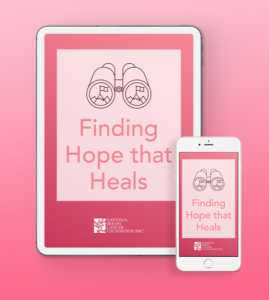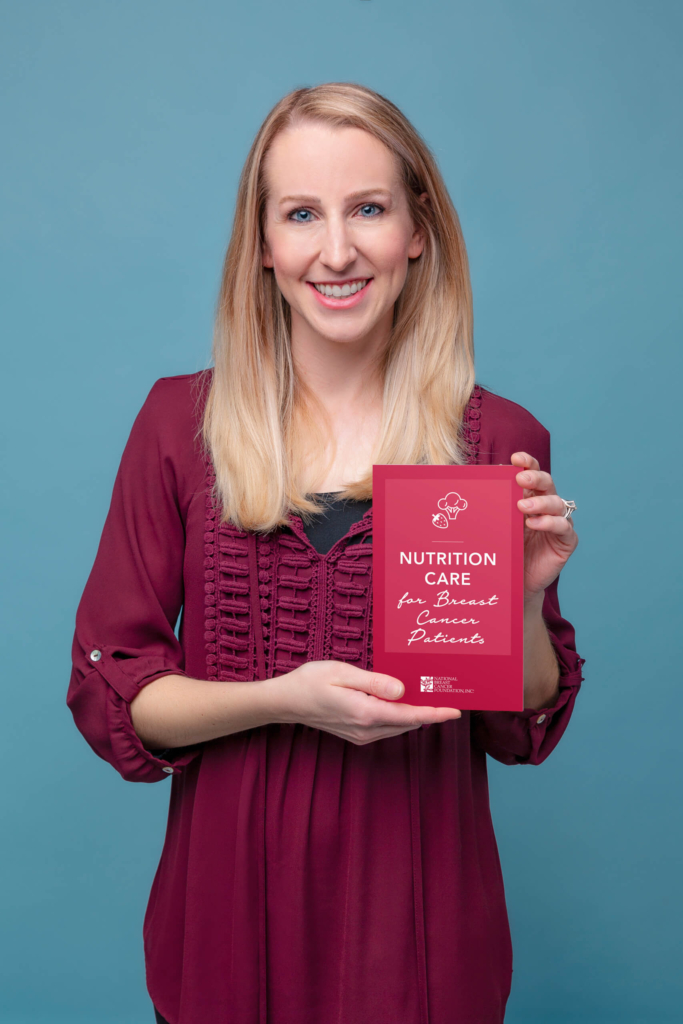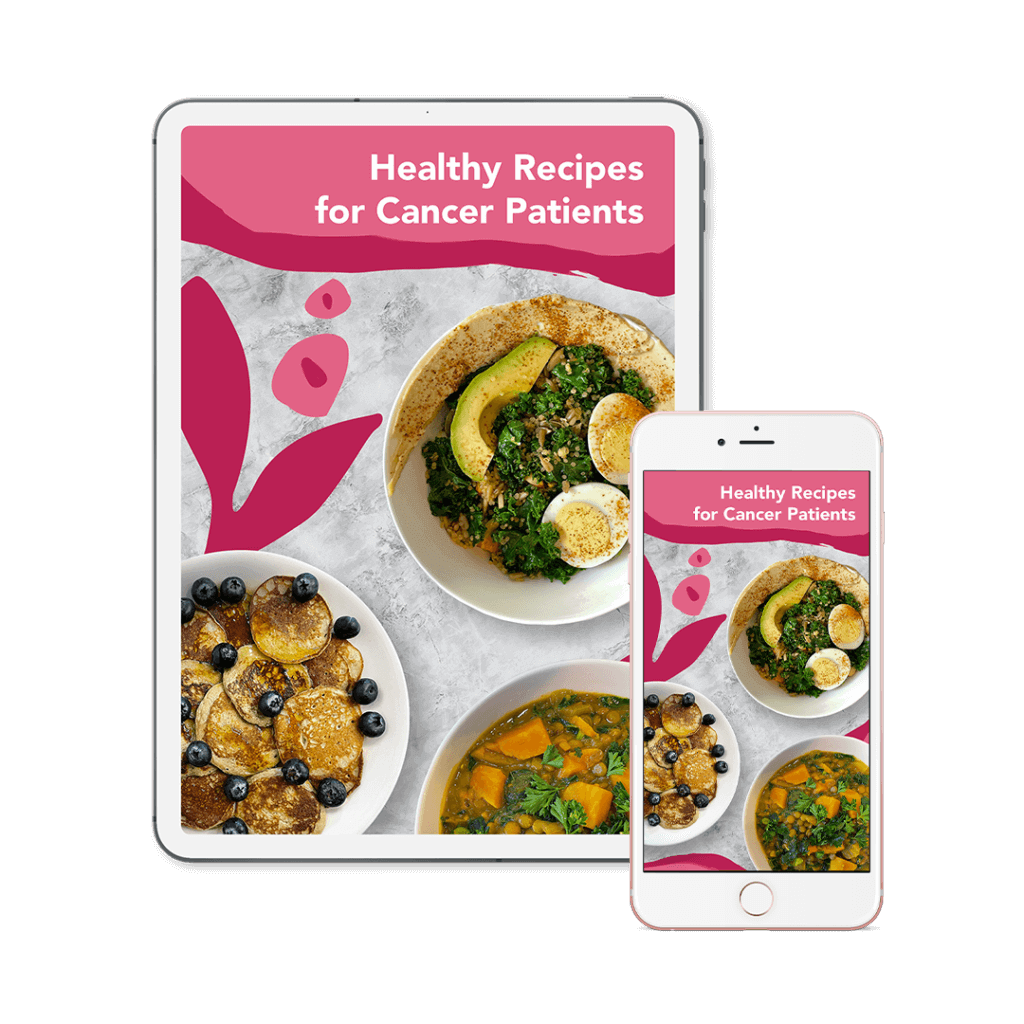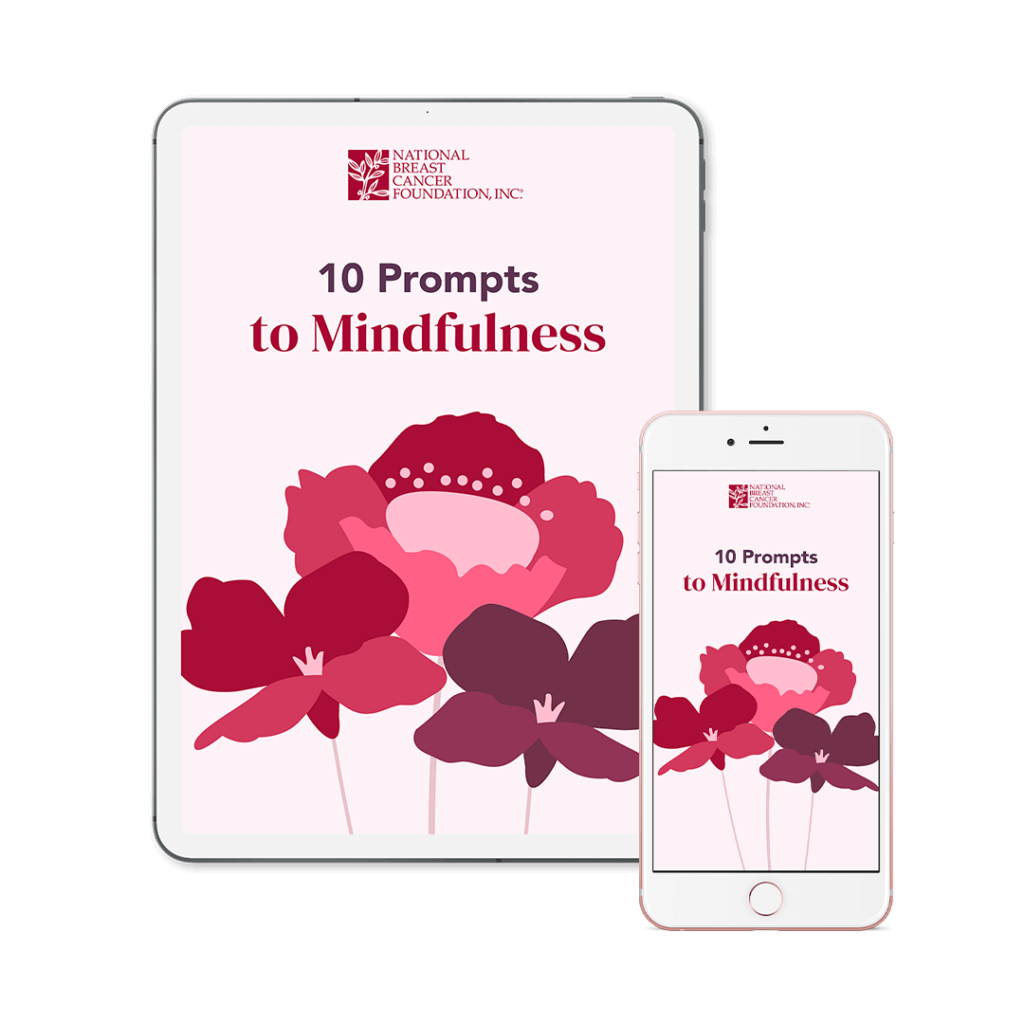Physical Activity, Wellness & Nutrition
Taking Care Of Yourself During Treatment And Beyond
It’s important for you to take good care of yourself before, during, and after cancer treatment. If you’re a caretaker, this is equally important as the demands of care taking can take a toll on your physical and mental health.
Taking care of yourself includes:
- Eating well by making healthy food choices
- Staying as active as you can
- Finding an exercise routine, such as walking, that works for you
- Understanding your thoughts, emotions, and reactions
- Taking time for yourself
- Prioritizing your mental health
- Exploring meditation & mindfulness
Jump to:
– Physical Activity
– Yoga
– How Yoga for Cancer Patients is Different
– Meditation
– How to Begin Meditation
– Free Meditation Resources
– Nutrition
– Free Nutrition Resources
– Mindfulness
– Free Mindfulness Resources
Physical Activity
It is okay to continue exercise during breast cancer treatment as long as your doctor okays your physical activity. Many women find that they feel better when they stay active. Walking, yoga, swimming, and other activities can keep you strong and increase your energy. Exercise may reduce nausea and pain and make treatment easier to handle. It also can help relieve stress. Whatever physical activity you choose, be sure to talk to your doctor before you start.
Also, if your activity causes you pain or other problems, be sure to let your doctor or nurse know.
Yoga
Yoga is a system of physical postures and breathing techniques to promote physical and emotional well-being. Research has shown that yoga can reduce the side effects of cancer and its treatments [1]. It is recommended to get between 150-320 minutes of exercise per week to speed recovery or defend against cancer occurrence and recurrence [2].
Not all yoga is the same and for cancer survivors the needs are different. Oncology based programs are required to provide safe and effective support.
How Yoga for Cancer Patients is Different
Specialized Training is Required
A specialized yoga teacher training about cancer helps teachers identify and work with the lifelong side effects triggered by cancer and its treatments. Yoga teachers need the essential facts about both cancer and yoga because understanding, not just compassion, is essential. Compassion might, for example, lead a teacher to provide only gentle or restorative poses for a cancer survivor. But yoga is not just a relaxation technique; movement is necessary to stimulate the cardiovascular and lymphatic systems that assist in recovery and in creating long-term stability.
Recent research suggests that the physical exercise provided by yoga improves immune function [3], reduces inflammation [4], and enhances the efficacy of chemotherapy and radiation [5]. Still, there are limits, especially right after surgery, or if a survivor is physically limited. Only training and supervised experience can inform a yoga teacher about safe and effective methods of adapting yoga for cancer survivors.
Safety Comes First
Healing begins with feeling safe. Safety for a cancer survivor, whether physical or psychological, can be different than for a typical student. The effects of some cancer treatments go beyond hair loss and fatigue to create serious long-term fragilities requiring special attention.
Emotional safety is important as well. Survivors bring their fears to class, such as the fear of developing lymphedema (fluid retention and swelling caused by a compromised lymphatic system), which may be as strong as the fear of cancer. Students need to hear that the teacher understands their fears and will know how to provide modifications of poses or sequences they teach. A student touched by cancer might be struggling to understand the new limitations of her body and will be looking for reassurance and informed advice.
Understanding Risk Factors
Like cancer, yoga is not “one size fits all.” Each survivor’s specific cancer, treatments, side effects, and body are different, and yoga teachers must adapt to their needs. The difference in teaching yoga to cancer survivors is that the risks are higher and a teacher should know what they are to best care for their students.
A short list of risk factors includes:
- Fragile bones that increase the risk of fracture
- Abdominal obstructions and sensitivities
- Weak or missing muscles
- Peripheral neuropathy (nerve pain in the hands or feet) affecting balance
- A compromised immune system, increasing the risk of infection
When offering a class for cancer survivors, a teacher is saying, “I am responsible. I know what yoga is best for you and I will protect you from possible discomfort and injury, and calm your doubts or fears with knowledge and facts.” Survivors expect teachers to understand three general topics:
- The effects of cancer treatments on the body
- The poses that have the most benefits
- The poses that can be harmful
Meditation
Meditation is a way to untangle our thoughts and the emotions associated with them. When we’re stressed or distracted, we’re focused on our reaction to something—an event, or a frustration, for example. Meditation teaches us to separate ourselves from our reaction and simply observe it, without attaching emotion. This awareness allows us to remain in the present moment, understand our thought patterns, and learn more about our emotions and ourselves.
Stress is a leading trigger of many health conditions, and current research shows that meditation can help with stress management, anxiety, sleep disorders, and chronic pain [6]. Meditation has been shown to increase the brain’s capacity for attention span, focus, and creativity. Recent studies have also shown that meditation can increase our compassion toward others [7].
How to Begin Meditation
Our partner, Meditation Studio, has shared tips on how to begin meditation as well as free resources linked below.
All you need to start your meditation practice is comfort and dedication. Find a comfortable place to sit, and be willing to commit to your practice at the same time each day. Do your best to stay committed and remember, if you skip a day, simply start again.
Begin slowly with just a few minutes a day, and increase the length of your practice over time. We all have busy schedules, but making time on the front end will help you manage your time more effectively in the long run. Practicing first thing in the morning can be helpful as it’s a nice way to start the day—fresh and clear, carrying your intention and your awareness through the rest of the day.
For beginners, it’s important not to sit too long. Meditations can range from two-, five-, ten-, and 15-minutes, all of which are suitable for beginners who want to start a daily practice. Committing to shorter daily meditations is better than doing a longer meditation once a week.
Think about meditation like exercise: start slowly and build up your endurance. Ten minutes a day is a great starting point, and with time, you might like to extend your meditation to 25 minutes or longer.
A common misconception about meditation is that you have to “stop thinking.” Because of the way our brains work, we are hard-wired to think—and the more we try to stop our thoughts, the more they pop up.
When your mind feels flooded, have patience with yourself, bring your attention back to your breath, and allow yourself to simply observe your train of thought. Over time—and with practice—your sense of ease and calm will increase.
Free Resources
Meditation Series
Meditation Studio is offering NBCF supporters free access to the Cancer Comfort Meditation Series.
This series includes:
- Managing Chronic Pain
- Breath as Ally
- Letting Others In
- Cultivating Self Compassion
- Facing Denial and Disappointment
- Facing Death and Grief
- Insomnia
- Building Strength and Resilience
Click here to listen to the free Cancer Comfort Meditation Series.

Finding Hope That Heals
Our latest eBook guides patients and caregivers to strengthen hopes that help and let go of those that may harm.
Tell us where we can send your free copy of the eBook, Finding Hope That Heals.

Nutrition
Eating well may actually help you feel better and have more energy. It’s important to do your best to eat the right amount of calories to maintain a healthy weight. Adequate protein can help to keep up your strength, too.
Sometimes, especially during or soon after treatment, you may not feel like eating. Some treatments can leave you feeling tired and uncomfortable. Or you may find that some foods don’t taste as good as they used to.
In addition, the side effects of treatment (such as poor appetite, nausea, vomiting, or mouth blisters) can make it hard to eat well. On the other hand, some women treated for breast cancer may have a problem with weight gain.
Your doctor, a registered dietitian, or another healthcare provider can suggest ways to help you meet your nutrition needs and remain as close to a healthy weight as you can. You can also check out our list of recommended foods to eat when undergoing cancer treatment.
Free Resources
Nutrition Care for Breast Cancer Patients eBook
Nutrition is an important, but sometimes overlooked, part of breast cancer treatment. Our new eBook Nutrition Care for Breast Cancer Patients will teach those in treatment and their caregivers about creating nutritious meals that are easy to prepare, safe to eat, and may help manage side effects from treatment.
Tell us where we can send your free eBook:

Healthy Recipes for Cancer Patients
Get our free cookbook featuring 10 healthy recipes from breakfast through dinner—plus healthy snack ideas, tips for food safety, simple options that make healthy cooking and nutrition more accessible, and pro tips from registered dietitian Annie Cavalier, MS, RDN, LD.
Where can we send your free cookbook?

Mindfulness
Mindfulness is the ability to be fully present and aware of your thoughts, feelings, and surrounding environment in a gentle, nurturing way. Mindfulness involves accepting your feelings and thoughts without judgment and understanding what you are sensing in the present moment rather than living in the past or imagining the future.
There is a powerful connection between mental health and physical health, a true mind and body connection. During treatment and beyond, it can be important to gain techniques to build, sustain, and maintain a strong mindset.
Roadmap to Mindfulness
A Mindfulness Roadmap is beneficial to help sustain, reflect, and shift your mindset. A common goal of mindfulness for patients and survivors is to adopt a growth mindset where your diagnosis doesn’t define you.
Dr. Carol Dweck has conducted over 30 years of research on the potential of growing and shifting our mindset. Her research discovered that we can retrain our brains to grow and develop stronger brain cells. Her research spanned children, adolescents, and adults and found that although we cannot change our IQ or personality traits, by shifting to a growth mindset, we can increase our emotional intelligence (self-awareness, social awareness, self-management, and relationship management).
Building a Growth Mindset
There are tangible mindset tools that anyone can implement and put to practice to develop a new mindset and lifestyle habits for managing through a cancer diagnosis.
- Address self-limiting beliefs
- Replace Automatic Negative Thoughts (ANTs)
- Focus on the present
- Practice self-reflection by journaling
- Use guided imagery
- Build principles of resilience
Self-Limiting Beliefs
The first step in building and sustaining a growth mindset is to recognize how self-limiting beliefs and negative thought patterns can affect the way we think, feel and behave.
Self-limiting beliefs are thoughts about yourself that keep you from living your best and most authentic self. They are not your reality and are caused by negative thought beliefs and patterns that are brought on in different ways. These can be caused from past beliefs and behaviors that were told or taught to you as a young child or teenager by parents, authority figures or friends (and often may not be intentionally done).
As you eliminate self-limiting beliefs and blocks, you begin to evolve your true belief, value and moral system. This involves how you perceive yourself (your reality), how you perceive those around you, and how you perceive yourself in the world.
We all have self-limiting beliefs and they can be eliminated at any age. If we do not address our self-limiting beliefs, they will inhibit our ability to grow and can limit what our role is in our community and the world around us. Eliminating self-limiting beliefs has a positive impact on your self-esteem but most importantly, your self-worth.
Automatic Negative Thoughts (ANTs)
As we develop a positive mindset, it’s important to rid our brain from automatic negative thoughts (ANTs). ANTs are automatic negative thought patterns about something we tell ourselves, something others tell us, or thoughts that are not true or may be self-limiting.
ANTs can come from all angles including what others tell us, what we hear on the news or read, and what we are telling ourselves. This can put our negative thoughts in a looping pattern in our brain. When we rid ourselves of ANTs we are retraining our brain (like retraining a muscle) to shift negative thoughts to positive thoughts and to what is true and real.
Begin to think about what negative internal talk that you want to change. Start with: What are you telling yourself? Why are you telling yourself this?
Focusing on the Present
Focusing on the present keeps your mind in a good state and allows you to experience gratitude for what you have.
If you find yourself thinking about the past or worrying too much about the future, then bring yourself back to the present and ask yourself what you are grateful for.
Having a “gratitude journal” will help you capture good thoughts and gratitude in the moment.
Ask yourself what three things you are thankful for, then say them and write them down every day or weekly. They can be big or small. At night ask yourself, what went right today and celebrate your successes for the day.
Journaling and Self-Reflection
One of the most impactful and powerful ways to get to know yourself is through journaling. Journaling helps you connect to your inner self and find wisdom to help figure out who you are, what you want, and what you need.
Journal prompts to help with self-discovery and self-reflection:
- How would you describe yourself in three words?
- How would others describe you in three words?
- What are your best qualities?
- What are the five most meaningful lessons you have learned this year?
- What are some of your favorite memories with family and friends?
- Your favorite way to spend the day and night is?
- The two life events that I will never forget are…Describe them in detail and what makes them so memorable.
- What 10 things make you smile the most?
- When you are feeling physical or mental discomfort, what things can you do to make yourself feel better?
- Write down compassionate and kind ways you have supported yourself and others.
Guided Imagery
Guided imagery is visualizing yourself being in a certain environment that relaxes you. Your guided imagery could be any activity or place you enjoy and resonate with that reduces your anxiety and stress.
When you are in a stressful place, whether it be professional or personal, use guided imagery and visualization to take you to a relaxing place.
Principles of Resilience
A resilient person works through challenges by using personal resources, strengths, and other positive capacities like hope, optimism, and self-efficacy.
The Principles of Resilience are:
- Positive self-image
- Problem-solving skills
- Self-regulation
- Adaptability
- Faith (understanding the meaning of one’s purpose)
- Positive outlook
- Skills and talents that are valued by self and community
- General acceptance by others
When applying the Principles of Resilience, start by implementing and practicing one or two principles at a time. For example, start by taking a self-image inventory. Make a list of your positive qualities, then lean on these strengths when dealing with challenges. If you are struggling to identify positive qualities on your own, reach out to a friend or loved one and ask them to help.
Next, focus on self-regulation by reflecting on your thoughts and feelings during a situation, specifically how you can control and manage them. It is important not to focus on what happens to you, but how you react to situations you’re faced with.
Once you feel the first two principles have become lifestyle habits, begin to work on one or two other Principles of Resilience.
Medically reviewed June 2023
Free Resource
10 Prompts to Mindfulness
This free guide will give you 10 short prompts for reflection to help incorporate gratitude, reflection, compassion, and self-love into your daily routine.
Tell us where we can send your free guide:

Material on this page courtesy of the National Cancer Institute, Meditation Studio, and Mental Wellness Unleashed.
Sources:
[1] Yoga for the Management of Cancer Treatment-Related Toxicities
[2] American Cancer Society, U.S. Department of Health and Human Services
[3] Regular Yoga Practice Improves Antioxidant Status, Immune Function, and Stress Hormone Releases in Young Healthy People: A Randomized, Double-Blind, Controlled Pilot Study
[4] Yoga’s Impact on Inflammation, Mood, and Fatigue in Breast Cancer Survivors: A Randomized Controlled Trial
[5] Yoga Helps Maintain Quality of Life, May Lessen Side Effects in Men Undergoing Prostate Cancer Treatment
[6] Brief, Daily Meditation Enhances Attention, Memory, Mood, and Emotional Regulation in Non-Experienced Meditators
[7] Concentrative Meditation Influences Creativity by Increasing Cognitive Flexibility



